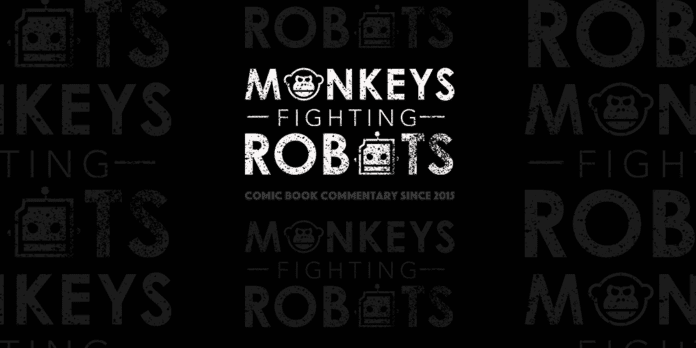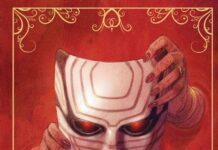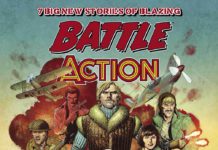Need to catch up? Check out our review of Fearscape #1.
“How do I become a writer?” It is the question that plagues many in the creative field. In our salad days, we may feel that there is some archaic secret to writing known only to a select few. If someone would just take us under their wing and reveal how the magician performs their trick, then it would all makes sense and overnight the talent that we know lies within would be unlocked. This is, of course, nonsense upon stilts. The harsh reality that many refuse to accept is that creative development can only come as a result of hard work and putting the effort into understanding your chosen craft. It’s a lesson that our “dear friend” and unreliable narrators: Henry Henry, has yet to reconcile himself with. In Fearscape #2 from Vault Comics, the team of Ryan O’Sullivan (writer), Andrea Mutti (illustrator), Vladimir Popov (colorist), and Andworld Designs (letterer) explore that harmful, cyclical mentality in a compelling fashion that I suspect will serve as a wakeup call to some aspiring creators among the readership.
For those who came in late, our story picks up with Henry Henry and the Muse continuing further into the titular Fearscape: the ethereal realm wherein humanity’s fear’s become manifest. Our once plagiarist and possible savior sets off to face humanity’s “First Fear” in the Weeping Castle as he prepares for his confrontation with the “Greatest of All Fears”. Hubris, however, remains his ultimate foe and Henry must learn to overcome his own ego if he hopes to become a storyteller worthy of the challenge ahead of him.
Issue two is where the tragedy, albeit one entirely of our protagonist’s own making, of Fearscape begins to crystallise. The supposed greatest storyteller that the world has never heard of has the Muse herself willing to guide him through the Fearscape and yet time and time again he rejects her, berates her. Why? Because she requires him to work to obtain the success he longs for. The Muse does not and can not give him what he wants because he is unwilling to commit himself to mastering and improving his craft. Her existence is an affront to the lie he has told himself throughout his life, that society would recognise and he could realise his genius if only he got a glimpse at the secret formula at the heart of creativity itself. Andworld Designs demonstrates Henry’s growing disgust for the Muse by literally having his captions talk over her attempts to explain the next portion of their quest. Henry expects that mere sight of the Muse should unlock his inner talent and yet, he feels no difference. The obscuring of dialogue by lettering becomes a way for Henry to hide those undesirable truths from both himself and the reader. Henry’s inability to confront his own shortcomings slowly eats away at him, causing a retreat into familiar and harmful platitudes of how a writer should be. Henry reveals himself to be far more interested in the idea of being a creative than actually doing what is necessary to achieve his dreams. Our narrator is a reflection of that most dreaded of afflictions: writer’s complex. He’s all talk, no write.
The creative team really dissect the fallacy of writer’s complex through a fascinating contrast between the techniques used in the first and second issues. Arguably, the most striking moment in the first issue of Fearscape was the blank nine-panel grid filled only with text decrying the tool as cow-towing to formalism and the stories that came before. For Henry Henry, the struggling writer at the heart of our story, this is his attempt to demonstrate his own originality. We are told that the grid is a crutch that a literary genius such as Henry does not need to rely on. It’s part of his ploy to woo the reader into thinking that is greater than he is by playing on arguments which hold surface level appeal to many but fail to stand up to scrutiny. The more Henry lauds his own talents the more and more skeptical of his initial treatise we become.
Yet in this issue, when experiencing a crisis of faith as a creator, we see Henry fall back on the same nine-panel grid he so despises. Except, it’s not an exact nine-panel grid. Mutti’s layouts may contain nine panels, but each of the rows are a different size to the other. It seems off and it should because it is an encapsulation of Henry’s need to give the appearance of originality over everything else. Henry’s entire public and private persona derives from his platonic ideal of an author, a solitary person whose creative ability is almost magical in nature, and to whom novelty in their craft is of paramount concern. The choice to use the nine-panel grid, but with the slightest of changes, is inspired as it subtlety plays into Henry’s self-deception. As long as he isn’t formally abiding to the strict formalism of the nine-panel grid then Henry, in his own mind, can still lay claim to his status as a champion of creative innovation. What’s sad about Henry as a character is that he doesn’t recognise it. This entire issue is our protagonist trying to convince himself of the value of his philosophy as much as he is his “dear readers”.
It is no surprise then that Henry Henry lampoons one of this issue’s new additions to the cast: a personification of Joseph Campbell’s Hero with a Thousand Faces. He is the trope that Henry desires to overcome, but cannot seem to tear himself away from. Mutti deserves all the credit that is sure to come his way for a wicked design that plays into the chameleonic nature of the Campbellian story structure. Likewise, Popov, whose painterly colours gives Fearscape its tone, demonstrates the power of this character through a fiery aura that can be felt from the page. The power that Popov infuses with the character is not a reflection of his own physical strength, but that of the myth and story structure that he embodies. There is a reason after all why so many authors, often unknowingly, fall back on The Hero’s Journey. Oh how infuriated Henry would be if he knew that he had fulfilled that age-old literary prophecy in rejecting the call to adventure. Where we leave our protagonist at the end of this issue, it is unclear whether he would care.
Much of this analysis could be misplaced if the creative team’s propensity to play games with the reader is anything to go by. Perhaps in looking at the book as we have we are falling into a trap joyfully set. Fearscape continues to prove, however, that comics can enrapture us even when we know full well that we are being messed with. Indeed, it is the very reason a book like Fearscape engages us so.
Fearscape #2 is available in all good comics shops and is published by Vault Comics.
A review copy was kindly provided by the writer.








